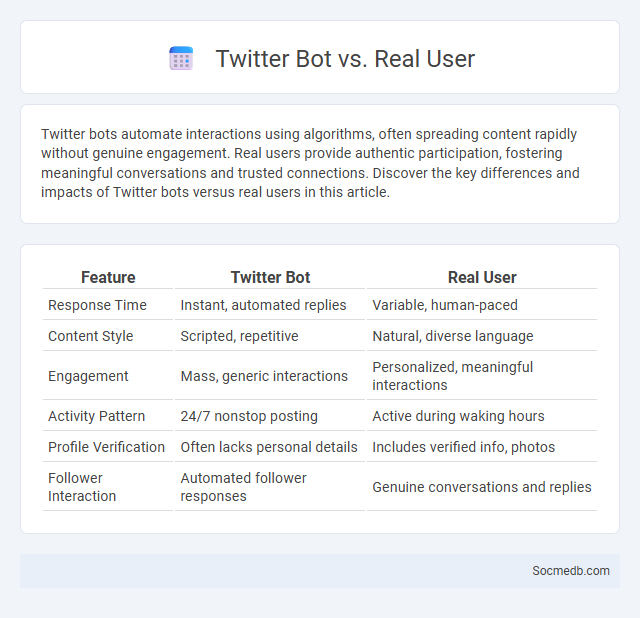
Photo illustration: Twitter Bot vs Real User
Twitter bots automate interactions using algorithms, often spreading content rapidly without genuine engagement. Real users provide authentic participation, fostering meaningful conversations and trusted connections. Discover the key differences and impacts of Twitter bots versus real users in this article.
Table of Comparison
| Feature | Twitter Bot | Real User |
|---|---|---|
| Response Time | Instant, automated replies | Variable, human-paced |
| Content Style | Scripted, repetitive | Natural, diverse language |
| Engagement | Mass, generic interactions | Personalized, meaningful interactions |
| Activity Pattern | 24/7 nonstop posting | Active during waking hours |
| Profile Verification | Often lacks personal details | Includes verified info, photos |
| Follower Interaction | Automated follower responses | Genuine conversations and replies |
Introduction to Twitter Bots and Real Users
Twitter bots automate interactions by posting, liking, and retweeting content based on programmed algorithms affecting engagement metrics and trending topics. Real users, in contrast, contribute genuine interactions driven by personal interests and emotions, which influence authentic community building and trust on the platform. Understanding the differences helps you discern the quality of content and engagement within your Twitter experience.
Defining Twitter Bots: Features and Functions
Twitter bots are automated accounts designed to perform specific tasks such as posting tweets, retweeting, liking, and following users based on predefined algorithms. These bots can disseminate information rapidly, engage in conversational interactions, or amplify trends and hashtags to influence public discourse. Advanced Twitter bots utilize machine learning to mimic human behavior, making them integral in marketing, customer service, and data analysis on the platform.
How to Identify Real Users on Twitter
Identifying real users on Twitter involves analyzing profiles for genuine engagement patterns, such as consistent posting behavior, authentic interactions, and followers with meaningful connections. Look for verified badges, detailed bios, and original content that reflect real-life experiences or expertise. Tools like Botometer can also assist in distinguishing automated accounts from legitimate users based on activity and network analysis.
Types of Twitter Bots and Their Purposes
Twitter bots encompass a variety of types including content bots that automatically post news or promotional material, engagement bots designed to like, retweet, or reply to increase visibility, and follower bots aimed at artificially boosting follower counts. Some bots serve specialized purposes such as customer service bots that respond to user inquiries, sentiment analysis bots that track public opinion, and monitoring bots that detect trends or breaking news. Understanding the diverse functionalities and intentions behind these Twitter bots is crucial for managing social media strategies and mitigating potential misuse.
Key Differences Between Twitter Bots and Real Users
Twitter bots automate posting, liking, and following based on programmed algorithms, often lacking genuine engagement or emotional nuance found in real users. Real users interact organically through personalized content, real-time conversations, and diverse opinions, contributing to authentic social media dynamics. Identifying these differences involves analyzing behavioral patterns such as posting frequency, language complexity, and network interactions to distinguish bots from humans.
Impact of Bots on Twitter’s Ecosystem
Bots significantly influence Twitter's ecosystem by amplifying content, shaping trends, and sometimes spreading misinformation, which can distort public perception and engagement metrics. These automated accounts contribute to both positive interactions, such as customer service and news dissemination, and negative activities, including spam, manipulation of political discourse, and artificial inflation of follower counts. Understanding the impact of bots on your Twitter experience is crucial to discerning authentic voices and maintaining a trustworthy online community.
Social Media Engagement: Bot vs Real User Behavior
Social media engagement differs significantly between bots and real users, with real users displaying diverse, context-rich interactions such as comments, shares, and likes driven by genuine interests and social connections. Bots typically generate repetitive, high-volume actions lacking authentic language patterns and emotional nuance, often used for manipulation or spam purposes. Advanced algorithms analyze engagement metrics like response time, content relevance, and interaction diversity to detect and differentiate bot activity from genuine user behavior on platforms like Facebook, Instagram, and Twitter.
Detection Techniques: Spotting Bots on Twitter
Detection techniques for spotting bots on Twitter rely heavily on machine learning algorithms analyzing behavioral patterns such as tweet frequency, retweet ratios, and follower-following dynamics. Advanced models utilize natural language processing to examine text coherence, sentiment, and repetition indicative of automated activity. Network analysis of account interactions and metadata, including creation date and IP address clusters, enhances accuracy in distinguishing genuine users from bot accounts.
Ethical Considerations: Bots vs Human Users
Ethical considerations in social media revolve around the distinction between bots and human users, impacting authenticity and trustworthiness. Bots can manipulate engagement metrics and spread misinformation, challenging platforms to ensure transparency and protect users. Your awareness of these differences is crucial for fostering a genuine online community and making informed decisions about content credibility.
Future Trends: Evolution of Twitter Bots and User Interaction
Twitter bots are evolving with advancements in AI, enabling more sophisticated and context-aware interactions that enhance user engagement. Increased integration of machine learning allows these bots to provide personalized responses, filter content, and detect misinformation more effectively. Future trends suggest Twitter bots will play a crucial role in shaping social media dynamics by automating real-time interactions and amplifying relevant content.
 socmedb.com
socmedb.com